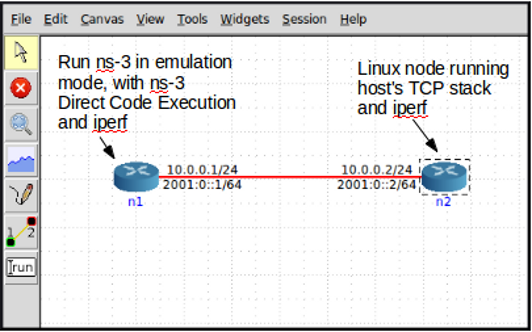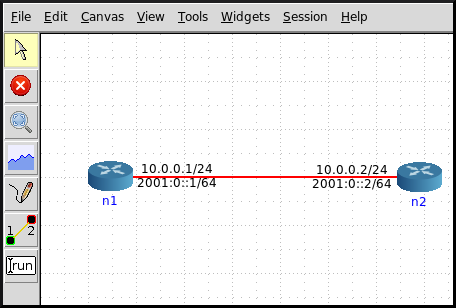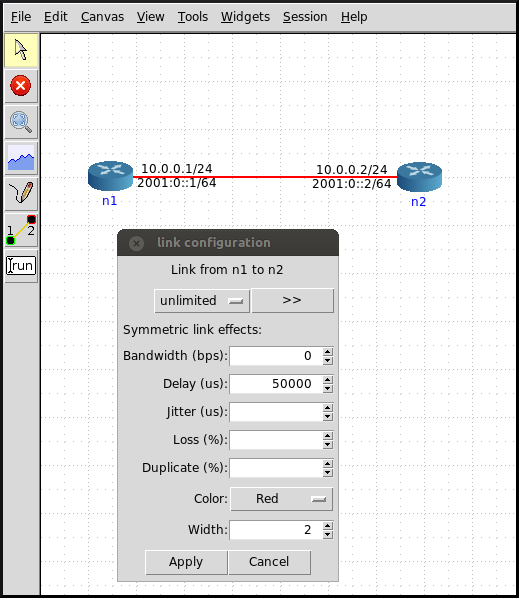Difference between revisions of "HOWTO use CORE to test ns-3 TCP"
(→Prerequisites) |
(TCP testing with iperf) |
||
| (3 intermediate revisions by the same user not shown) | |||
| Line 30: | Line 30: | ||
updating to branch default | updating to branch default | ||
45 files updated, 0 files merged, 0 files removed, 0 files unresolved | 45 files updated, 0 files merged, 0 files removed, 0 files unresolved | ||
| + | $ cd bake | ||
$ export BAKE_HOME=`pwd` | $ export BAKE_HOME=`pwd` | ||
$ export PATH=$PATH:$BAKE_HOME | $ export PATH=$PATH:$BAKE_HOME | ||
| Line 110: | Line 111: | ||
== Setting up CORE == | == Setting up CORE == | ||
| − | Create a simple two-node topology using the CORE GUI and the default IP addresses that it provides. It should look like the below | + | Create a simple two-node topology using the CORE GUI and the default IP addresses that it provides. It should look like the below. |
| + | |||
| + | [[File:Core-tcp-scenario.png]] | ||
Start CORE. The ns-3 node is going to be the one on the left (10.0.0.1). The container node is going to be on the right. | Start CORE. The ns-3 node is going to be the one on the left (10.0.0.1). The container node is going to be on the right. | ||
| Line 133: | Line 136: | ||
# ifconfig eth0 promisc | # ifconfig eth0 promisc | ||
| + | |||
| + | There is one final manual step. The ns-3 program, when it runs, will assume the IP address 10.0.0.1/24 on its interface. The underlying CORE container also is configured for 10.0.0.1/24. This may lead to ARP race conditions; we do not want the container replying to n2's ARP requests. The solution is to delete the IP address 10.0.0.1 from the n0 container, and add another temporary address (the DCE program will assert if there is no IP address on the underlying interface). | ||
| + | |||
| + | # ip addr del 10.0.0.1/24 dev eth0 | ||
| + | # ip addr add 10.1.2.3/24 dev eth0 | ||
| + | |||
| + | Add some propagation delay to the CORE link, by double clicking on the red link line, and adding the value 50000 to the link delay field. Click "Apply". The link should now show '50ms' below the line. | ||
| + | |||
| + | [[File:Core-tcp-scenario-with-delay.png]] | ||
| + | |||
| + | == Running iperf and DCE == | ||
| + | |||
| + | From the bake directory, and in a core shell on node n0, cd into the 'ns-3-dce' directory. The file that this HOWTO demonstrates is located at 'example/dce-iperf-emulation.cc' (note: this is a new file added to DCE as of Sept 2014). This is an adaptation of the non-emulation 'example/dce-iperf.cc' and has two options of interest: | ||
| + | |||
| + | ./waf --run "dce-iperf-emulation --help" | ||
| + | dce-iperf-emulation [Program Arguments] [General Arguments] | ||
| + | Program Arguments: | ||
| + | --stack: Name of DCE IP stack: ns3/linux/freebsd. Default: [ns3] | ||
| + | --udp: Use UDP. Default: [false] | ||
| + | --bw: UDP bandwidth limit. Default: [1m] | ||
| + | --emulation: Use emulation. Default: [false] | ||
| + | --clientNode: Client node (0 or 1). Default: [0] | ||
| + | General Arguments: | ||
| + | --PrintGlobals: Print the list of globals. | ||
| + | --PrintGroups: Print the list of groups. | ||
| + | --PrintGroup=[group]: Print all TypeIds of group. | ||
| + | --PrintTypeIds: Print all TypeIds. | ||
| + | --PrintAttributes=[typeid]: Print all attributes of typeid. | ||
| + | --PrintHelp: Print this help message. | ||
| + | |||
| + | We need to enable emulation, and we want to demonstrate having ns-3 act as either the server or the client. ns-3 will run on node 'n0', and the native iperf will run on node n1. | ||
| + | |||
| + | For the first case, ns-3 will run as the client. On a shell on node n1, start iperf as the server: | ||
| + | |||
| + | [root@n2 n2.conf]# iperf -s | ||
| + | |||
| + | On the node n0, run the program from the ns-3-dce directory as follows: | ||
| + | |||
| + | [root@n1 n1.conf]# ./waf --run "dce-iperf-emulation --emulation=1 --clientNode=0" | ||
| + | |||
| + | In the server window, one should see something like: | ||
| + | |||
| + | ------------------------------------------------------------ | ||
| + | Server listening on TCP port 5001 | ||
| + | TCP window size: 85.3 KByte (default) | ||
| + | ------------------------------------------------------------ | ||
| + | [ 4] local 10.0.0.2 port 5001 connected with 10.0.0.1 port 49153 | ||
| + | [ ID] Interval Transfer Bandwidth | ||
| + | [ 4] 0.0-11.0 sec 19.1 MBytes 14.6 Mbits/sec | ||
| + | |||
| + | Now, reverse the direction. Kill the iperf server on node n1. To set up ns-3 as the server, type in n0: | ||
| + | |||
| + | ./waf --run "dce-iperf-emulation --emulation=1 --clientNode=1" | ||
| + | |||
| + | and quickly type in the following to the n1 shell (the ns-3 program only runs for 30 seconds): | ||
| + | |||
| + | iperf -c 10.0.0.1 -i 1 -t 10 | ||
| + | |||
| + | One should see something like this displayed on the n1 shell: | ||
| + | |||
| + | ------------------------------------------------------------ | ||
| + | Client connecting to 10.0.0.1, TCP port 5001 | ||
| + | TCP window size: 45.0 KByte (default) | ||
| + | ------------------------------------------------------------ | ||
| + | [ 3] local 10.0.0.2 port 39384 connected with 10.0.0.1 port 5001 | ||
| + | [ ID] Interval Transfer Bandwidth | ||
| + | [ 3] 0.0- 1.0 sec 1.38 MBytes 11.5 Mbits/sec | ||
| + | [ 3] 1.0- 2.0 sec 2.25 MBytes 18.9 Mbits/sec | ||
| + | [ 3] 2.0- 3.0 sec 2.12 MBytes 17.8 Mbits/sec | ||
| + | [ 3] 3.0- 4.0 sec 2.00 MBytes 16.8 Mbits/sec | ||
| + | [ 3] 4.0- 5.0 sec 2.12 MBytes 17.8 Mbits/sec | ||
| + | [ 3] 5.0- 6.0 sec 2.12 MBytes 17.8 Mbits/sec | ||
| + | [ 3] 6.0- 7.0 sec 2.12 MBytes 17.8 Mbits/sec | ||
| + | [ 3] 7.0- 8.0 sec 1.88 MBytes 15.7 Mbits/sec | ||
| + | [ 3] 8.0- 9.0 sec 2.12 MBytes 17.8 Mbits/sec | ||
| + | [ 3] 9.0-10.0 sec 2.12 MBytes 17.8 Mbits/sec | ||
| + | [ 3] 0.0-10.1 sec 20.4 MBytes 17.0 Mbits/sec | ||
Latest revision as of 01:34, 11 September 2014
Main Page - Current Development - Developer FAQ - Tools - Related Projects - Project Ideas - Summer Projects
Installation - Troubleshooting - User FAQ - HOWTOs - Samples - Models - Education - Contributed Code - Papers
This is a use case for the parent page of HOWTO Use CORE to test ns-3 protocols
Use case summary
We want to test the operation of ns-3's TCP with the TCP of other operating systems, for correctness and interoperability. We want the ns-3 TCP to operate as a client and a server (in different test runs).
A key consideration is what will be the application that will drive the TCP. Note that if there are any application-level semantics in the bit stream being exchanged, whatever is sitting on top of ns-3's TCP must be able to interoperate with whatever is sitting on top of the real node's TCP.
Iperf is a popular testing tool, but it has exactly these types of application-level semantics-- iperf will not interoperate with an ns-3 application. Fortunately, the ns-3 Direct Code Execution mode supports iperf, so we will describe that herein.
Another alternative (not written up here) would be to use Stevens's sock program as the real node's application, and either BulkSendApplication or PacketSink as the ns-3 application.
Prerequisites
We are aiming for the following configuration, where CORE can be used to add delay and packet errors.
First, download bake as described in the bake quick-start guide:
$ hg clone http://code.nsnam.org/bake destination directory: bake requesting all changes adding changesets adding manifests adding file changes added 323 changesets with 779 changes to 63 files updating to branch default 45 files updated, 0 files merged, 0 files removed, 0 files unresolved $ cd bake $ export BAKE_HOME=`pwd` $ export PATH=$PATH:$BAKE_HOME $ export PYTHONPATH=$PYTHONPATH:$BAKE_HOME $ mkdir dce $ cd dce $ bake.py configure -e dce-ns3-1.3 $ bake.py download && bake.py build >> Searching for system dependency libpcap-dev - OK >> Searching for system dependency libexpat-dev - OK >> Downloading iperf - OK >> Downloading wget - OK >> Downloading thttpd - OK >> Searching for system dependency python-dev - OK >> Searching for system dependency pygraphviz - OK >> Searching for system dependency pygoocanvas - OK >> Downloading pybindgen-0.17.0.868 - OK >> Searching for system dependency g++ - OK >> Searching for system dependency libc-debug - Problem > Problem: Optional dependency, module "libc-debug" not available This may reduce the functionality of the final build. However, bake will continue since "libc-debug" is not an essential dependency. For more information call bake with -v or -vvv, for full verbose mode. >> Searching for system dependency qt4 - OK >> Downloading ccnx - OK >> Downloading elf-loader - OK >> Downloading netanim-3.105 - OK >> Downloading ns-3.20 - OK >> Downloading dce-meta-1.3 (target directory:ns-3-dce) - OK >> Downloading dce-ns3-1.3 (target directory:ns-3-dce) - (Nothing to do, source directory already exists) - OK >> Building iperf - OK >> Building wget - OK >> Building thttpd - OK >> Building pybindgen-0.17.0.868 - OK >> Building ccnx - OK >> Building elf-loader - OK >> Building netanim-3.105 - OK >> Building ns-3.20 - OK >> Building dce-ns3-1.3 - OK
Now run the iperf example as shown in the quick start guide.
$ cd source/ns-3-dce/ $ ./waf --run dce-iperf Waf: Entering directory `/path/to/bake/dce/source/ns-3-dce/build' ... 'build' finished successfully (0.551s)
And look at the resulting stdout files:
$ cat files-1/var/log/*/stdout ------------------------------------------------------------ Server listening on TCP port 5001 TCP window size: 124 KByte (default) ------------------------------------------------------------ [ 4] local 10.1.1.2 port 5001 connected with 10.1.1.1 port 49153 [ ID] Interval Transfer Bandwidth [ 4] 0.0-11.2 sec 5.75 MBytes 4.31 Mbits/sec $ cat files-0/var/log/*/stdout ------------------------------------------------------------ Client connecting to 10.1.1.2, TCP port 5001 TCP window size: 124 KByte (default) ------------------------------------------------------------ [ 3] local 10.1.1.1 port 49153 connected with 10.1.1.2 port 5001 [ ID] Interval Transfer Bandwidth [ 3] 0.0- 1.0 sec 640 KBytes 5.24 Mbits/sec [ 3] 1.0- 2.0 sec 512 KBytes 4.19 Mbits/sec [ 3] 2.0- 3.0 sec 640 KBytes 5.24 Mbits/sec [ 3] 3.0- 4.0 sec 512 KBytes 4.19 Mbits/sec [ 3] 4.0- 5.0 sec 640 KBytes 5.24 Mbits/sec [ 3] 5.0- 6.0 sec 512 KBytes 4.19 Mbits/sec [ 3] 6.0- 7.0 sec 512 KBytes 4.19 Mbits/sec [ 3] 7.0- 8.0 sec 640 KBytes 5.24 Mbits/sec [ 3] 8.0- 9.0 sec 512 KBytes 4.19 Mbits/sec [ 3] 9.0-10.0 sec 640 KBytes 5.24 Mbits/sec [ 3] 0.0-10.2 sec 5.75 MBytes 4.73 Mbits/sec
This validates that DCE can run iperf between two ns-3 nodes. Next, we want to change the program to use ns-3 emulation mode.
Setting up CORE
Create a simple two-node topology using the CORE GUI and the default IP addresses that it provides. It should look like the below.
Start CORE. The ns-3 node is going to be the one on the left (10.0.0.1). The container node is going to be on the right.
The devices in the containers need to be in the proper state: any hardware offloading should be off, and device eth0 needs to have promiscuous turned on.
Obtain a shell on n0 and n1 and type 'ethtool --show-offload' at the prompt. If it displays:
# ethtool --show-offload eth0 Features for eth0: rx-checksumming: on tx-checksumming: on ... generic-segmentation-offload: on
These features must be disabled as follows:
# ethtool -K eth0 gso off # ethtool --offload eth0 rx off tx off
Additionally, on node n0, if promiscuous bit is not set on eth0, it must be enabled:
# ifconfig eth0 promisc
There is one final manual step. The ns-3 program, when it runs, will assume the IP address 10.0.0.1/24 on its interface. The underlying CORE container also is configured for 10.0.0.1/24. This may lead to ARP race conditions; we do not want the container replying to n2's ARP requests. The solution is to delete the IP address 10.0.0.1 from the n0 container, and add another temporary address (the DCE program will assert if there is no IP address on the underlying interface).
# ip addr del 10.0.0.1/24 dev eth0 # ip addr add 10.1.2.3/24 dev eth0
Add some propagation delay to the CORE link, by double clicking on the red link line, and adding the value 50000 to the link delay field. Click "Apply". The link should now show '50ms' below the line.
Running iperf and DCE
From the bake directory, and in a core shell on node n0, cd into the 'ns-3-dce' directory. The file that this HOWTO demonstrates is located at 'example/dce-iperf-emulation.cc' (note: this is a new file added to DCE as of Sept 2014). This is an adaptation of the non-emulation 'example/dce-iperf.cc' and has two options of interest:
./waf --run "dce-iperf-emulation --help" dce-iperf-emulation [Program Arguments] [General Arguments] Program Arguments: --stack: Name of DCE IP stack: ns3/linux/freebsd. Default: [ns3] --udp: Use UDP. Default: [false] --bw: UDP bandwidth limit. Default: [1m] --emulation: Use emulation. Default: [false] --clientNode: Client node (0 or 1). Default: [0] General Arguments: --PrintGlobals: Print the list of globals. --PrintGroups: Print the list of groups. --PrintGroup=[group]: Print all TypeIds of group. --PrintTypeIds: Print all TypeIds. --PrintAttributes=[typeid]: Print all attributes of typeid. --PrintHelp: Print this help message.
We need to enable emulation, and we want to demonstrate having ns-3 act as either the server or the client. ns-3 will run on node 'n0', and the native iperf will run on node n1.
For the first case, ns-3 will run as the client. On a shell on node n1, start iperf as the server:
[root@n2 n2.conf]# iperf -s
On the node n0, run the program from the ns-3-dce directory as follows:
[root@n1 n1.conf]# ./waf --run "dce-iperf-emulation --emulation=1 --clientNode=0"
In the server window, one should see something like:
------------------------------------------------------------ Server listening on TCP port 5001 TCP window size: 85.3 KByte (default) ------------------------------------------------------------ [ 4] local 10.0.0.2 port 5001 connected with 10.0.0.1 port 49153 [ ID] Interval Transfer Bandwidth [ 4] 0.0-11.0 sec 19.1 MBytes 14.6 Mbits/sec
Now, reverse the direction. Kill the iperf server on node n1. To set up ns-3 as the server, type in n0:
./waf --run "dce-iperf-emulation --emulation=1 --clientNode=1"
and quickly type in the following to the n1 shell (the ns-3 program only runs for 30 seconds):
iperf -c 10.0.0.1 -i 1 -t 10
One should see something like this displayed on the n1 shell:
------------------------------------------------------------ Client connecting to 10.0.0.1, TCP port 5001 TCP window size: 45.0 KByte (default) ------------------------------------------------------------ [ 3] local 10.0.0.2 port 39384 connected with 10.0.0.1 port 5001 [ ID] Interval Transfer Bandwidth [ 3] 0.0- 1.0 sec 1.38 MBytes 11.5 Mbits/sec [ 3] 1.0- 2.0 sec 2.25 MBytes 18.9 Mbits/sec [ 3] 2.0- 3.0 sec 2.12 MBytes 17.8 Mbits/sec [ 3] 3.0- 4.0 sec 2.00 MBytes 16.8 Mbits/sec [ 3] 4.0- 5.0 sec 2.12 MBytes 17.8 Mbits/sec [ 3] 5.0- 6.0 sec 2.12 MBytes 17.8 Mbits/sec [ 3] 6.0- 7.0 sec 2.12 MBytes 17.8 Mbits/sec [ 3] 7.0- 8.0 sec 1.88 MBytes 15.7 Mbits/sec [ 3] 8.0- 9.0 sec 2.12 MBytes 17.8 Mbits/sec [ 3] 9.0-10.0 sec 2.12 MBytes 17.8 Mbits/sec [ 3] 0.0-10.1 sec 20.4 MBytes 17.0 Mbits/sec


